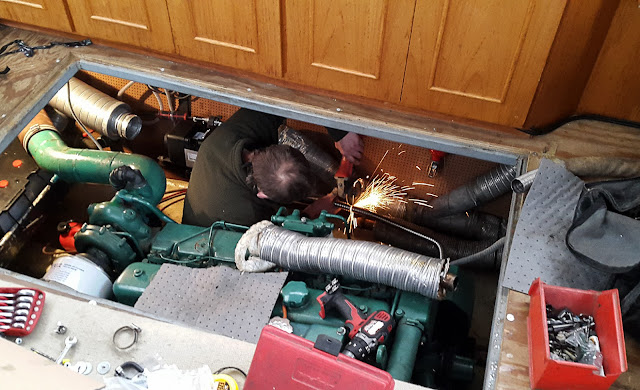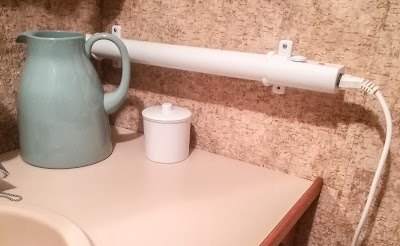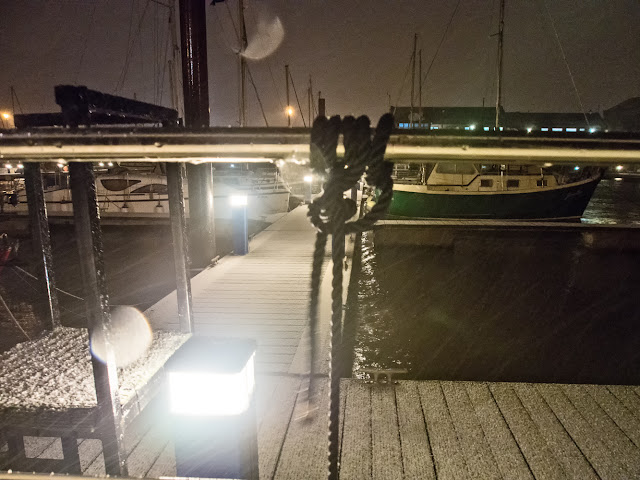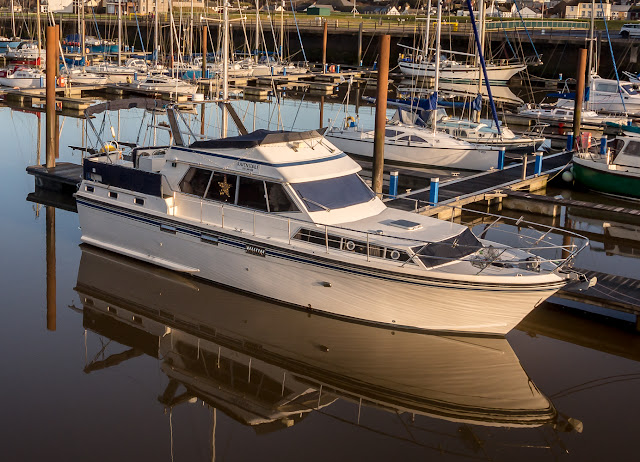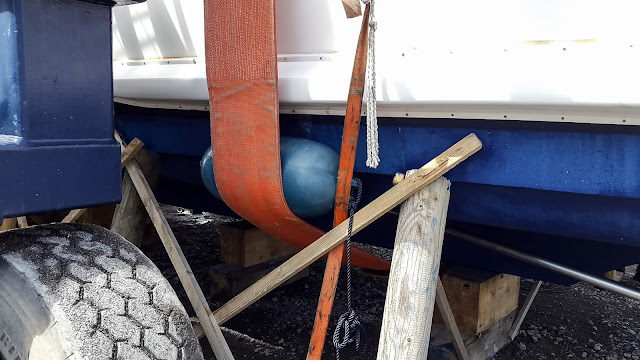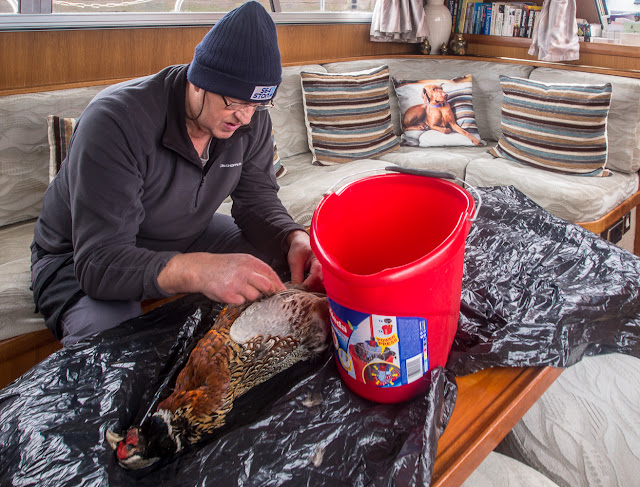 |
Ravensdale's troublesome heat exchanger is lifted out onto the saloon floor |
The past week probably rates as the most worrying since we moved on board our 43ft seagoing cruiser almost 15 months ago.
For a short while, it looked as though one of Ravensdale’s engines had a very serious problem. So much so that a local man with extensive experience of keeping fishing boats running told us he had no idea what the problem could be.
After working on her starboard engine for the best part of two days, he sat in our saloon on Tuesday afternoon looking down at the engine, shaking his head and basically giving us the impression that it was done.
 |
Phil watches Norman disconnect the intercooler |
I couldn’t help thinking that I’d somehow tempted fate when I wrote last week’s blog about our super-efficient heating system on Ravensdale.
We had to resort to heating the boat with the gas oven and a dehumidifier until Phil could have a proper look at it the following morning.
We then discovered that the lights dimmed every time we used anything else on the 24V system.
We had no heating Tuesday evening, overnight and Wednesday morning.
Phil started investigating the cause of the problem the following morning to discover that the battery charger wasn’t working.
He couldn’t identify the cause of the problem so we called in a marine electrician, who’d previously carried out work on Ravensdale.
He turned up a couple of hours later to discover that the switch by the mains input that takes 240V to the charger for the 24V system was off.
Phil was kicking himself for not checking the switch, but we never touch it and had no reason to even think it might have been turned off.
We can only think that it happened accidentally during the work being carried out in the engine room.
Thankfully, the electrician could see the funny side of the situation, but we’ve definitely learnt a lesson – always check something is switched on before calling in the experts J
Ravensdale’s overheating problem
The last time we took Ravensdale out to sea, she had a problem with her starboard engine overheating at speed.
The port engine was running just fine whatever speed she was doing.
But the temperature of her starboard engine showed a marked increase if we took her over about 12 knots and on one occasion, before we noticed this problem, the warning light on the temperature gauge came on and the alarm started going off.
Reducing the engine speed very quickly brought the temperature back down again.
 |
Ravensdale out on the Solway Firth |
Some people suggested this was easily remedied by keeping to 12 knots and below, but we weren’t happy to do this as we felt the overheating must be indicative of an underlying problem.
After asking around at our marina at Maryport in Cumbria, UK, Norman, who’s been keeping his family’s fishing boats running for years, agreed to come and see if he could get to the root of it.
Christmas and New Year, followed by bad weather and his other workload meant he hadn’t got around to us yet.
Phil had said he wanted the problem rectified before taking Ravensdale out again and, up until last weekend, it hadn’t mattered that we were still waiting for the work to be done.
However, on Saturday, the weather was fine and bright and there was very little wind. The tide times also meant the marina gate was open for almost five daylight hours.
It was an opportunity we would almost certainly have taken advantage of under normal circumstances, but we decided against for two reasons – I still wasn’t really feeling 100% after the flu bug and we really wanted Ravensdale’s overheating problem sorted before taking her out again.
So, when I saw Norman go down to his boat on Sunday, I went along to see when he might be able to fit us in and he said he’d be with us at 8am the following morning.
This meant a bit of an early start for us as we needed to dismantle the seating on the starboard side of the saloon and lift the floor to provide access to the engine before he arrived.
However, we considered it well worth getting up early if it solved Ravensdale’s overheating problem.
Trying to trace the cause of the problem
Norman started by examining the pipes and the jubilee clips on the system and discovered a perished hose and old jubilee clips that needed replacing.
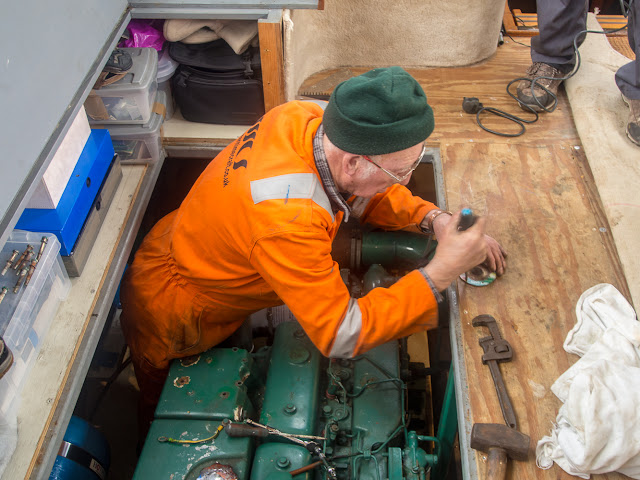 |
Norman fitting the cereal packet gasket |
He then set about removing the intercooler, which proved more difficult than he had expected due to the way it was designed and because it had apparently not been removed since the boat was built in 1984.
Norman eventually managed to prise it free and took it away to clean it with a compressor.
 |
Phil and Norman inspect the intercooler |
Meanwhile, he sent us to a nearby motor parts store to buy gasket paper and RTV silicone instant gasket.
He said he would return at around 8am on Tuesday morning, which meant another early start, but we didn’t mind at all as we just wanted to get the job done.
Norman replaced the intercooler and checked the thermostats, both of which seemed to be working.
 |
Norman checking the thermostats |
Phil passed him the tools he needed and held a torch to shed light on the area on which he was working.
My job was to cut some new gaskets for the intercooler from the filter paper we’d bought the previous day.
 |
Me punching holes in the gaskets I had cut |
Norman connected everything back up, then realised that there was no seawater in the cooling system because the filter was partially above sea level and the water in the system had drained down.
He got Phil to start the engine in the hope that the pump would suck the water in, but this did not happen so he had to top up the filter to provide sufficient water to get it circulating again.
The engine sounded fine. However, when they checked the water outlet, they discovered that there was only a trickle of water coming through and steam started coming out at about 1,000 revs.
It was at this point that things were not looking good for Ravensdale.
After much soul-searching during a coffee break, Norman decided that the only thing he could try now was to take off the heat exchanger and take that away and clean it too.
He hadn’t thought this would be necessary as he was convinced that any blockage would be in the intercooler, but he decided it was worth trying as a last resort.
The heat exchanger was much bigger than the intercooler and even more difficult to remove. When he eventually managed to remove it, he discovered that it was full of sludge.
 |
Phil helps Norman with the troublesome heat exchanger |
Phil gave Norman a lift home with the heat exchanger so he could clean it up and he returned the following morning to say he hadn’t been able to clean it with a pressure washer or a compressor so he had it soaking in caustic soda.
He said he’d let us know when it was ready to go back on.
And yesterday (Thursday) morning we got a call to say we could collect it from his home.
We brought Norman back with the heat exchanger and, after making new gaskets for it, he connected it up.
Then came the moment of truth...
 |
Water coming out of the outlet for Ravensdale's starboard engine |
Severe weather warnings
The Met Office issued a yellow "be aware" warning for snow and ice for much of the UK for Sunday.
The area covered by the warning came within eight miles of Maryport and, although the snow we had here was too wet to settle, it was falling fairly heavily for a while on Sunday morning.
 |
The snowy view from Ravensdale's aft deck |
 |
Snow falling at Maryport Marina in Cumbria |
And we didn’t get much sleep overnight Tuesday into Wednesday as Storm Georgina lashed the west coast with 45mph southerly winds, gusting up to 59mph.
This caused some fairly dramatic rocking and the water splashing against the hull seemed to be particularly noisy.
The high winds continued throughout much of the day on Wednesday.
The dreaded lurgy
I am almost fully recovered from the flu bug that made me so unwell for the best part of a fortnight.
It’s now almost three weeks since the symptoms started and all that’s left is a persistent cough.
I’m hoping it will disappear fairly soon, although I know of people who’ve been back at work for three weeks after suffering this bug who’ve still not managed to shake off the cough.
We thought Phil was getting it a few times as he had headaches and felt generally under the weather, but he’s still managing to fight it off.
Cooking with gas
 |
Ravensdale's gas stove and hob |
I recently realised I hadn’t worked out how much we spend on gas for our cooker, which is also used to boil water for cups of tea.
Well, we now know...
We started using a 13kg propane cylinder on November 15 and it ran out on Tuesday of this week, which means it lasted one day short of 9 weeks.
We started using a 13kg propane cylinder on November 15 and it ran out on Tuesday of this week, which means it lasted one day short of 9 weeks.
A 13kg cylinder costs £28, which means we’re spending just over £3 per week on gas.



